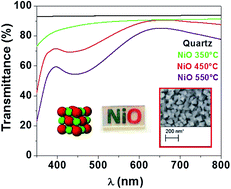Morphology-controlled synthesis of NiO films: the role of the precursor and the effect of the substrate nature on the films' structural/optical properties
Abstract
NiO thin films were grown through metalorganic chemical vapour deposition (MOCVD) on quartz and LaAlO3 (001) single crystal substrates. Two different volatile and thermally stable nickel β-diketonate adducts, Ni(hfa)2·tmeda and Ni(tta)2·tmeda [H-hfa = 1,1,1,5,5,5-hexafluoro-2,4-pentandione; tmeda = N,N,N′,N′-tetramethylethylendiamine, Htta = 2-thenoyltrifluoroacetone], were applied as precursors for NiO film growth. The comprehensive study, applying two different precursors and changing the processing parameters, allowed for morphological control of the deposited NiO films. The AFM analyses indicated different values of roughness for NiO films obtained from the two different precursors and those from Ni(tta)2·tmeda showed a lower roughness. In addition, UV-Vis and ellipsometric measurements on NiO films grown from the Ni(tta)2·tmeda show higher transparency, fewer defects/impurities, better crystallinity and a higher refractive index than films deposited using the Ni(hfa)2·tmeda source. Raman spectroscopy confirmed the antiferromagnetic nature of the NiO layers. Work functions, around 5.1 eV, were measured by Kelvin Probe Force Microscopy for NiO films grown from Ni(tta)2·tmeda. The relationship between the precursor/substrate nature and film properties allowed us to define the best precursor and conditions for the MOCVD growth of good quality NiO films.


 Please wait while we load your content...
Please wait while we load your content...